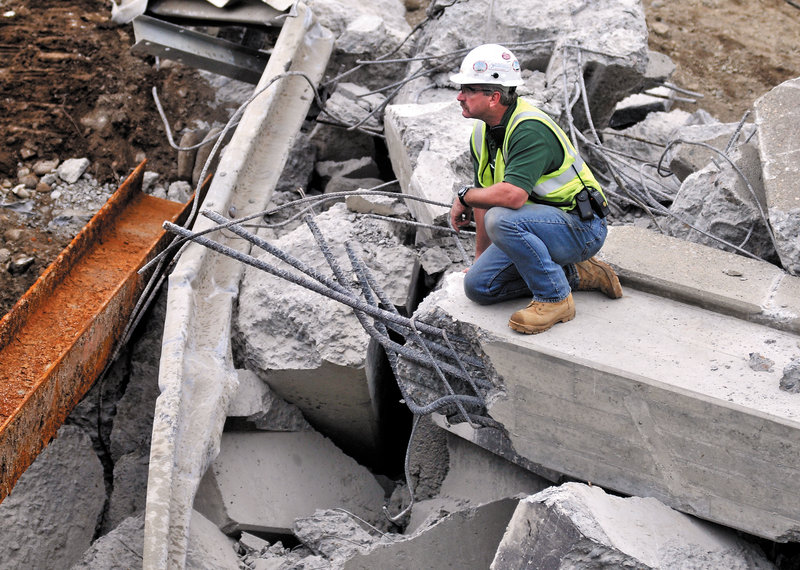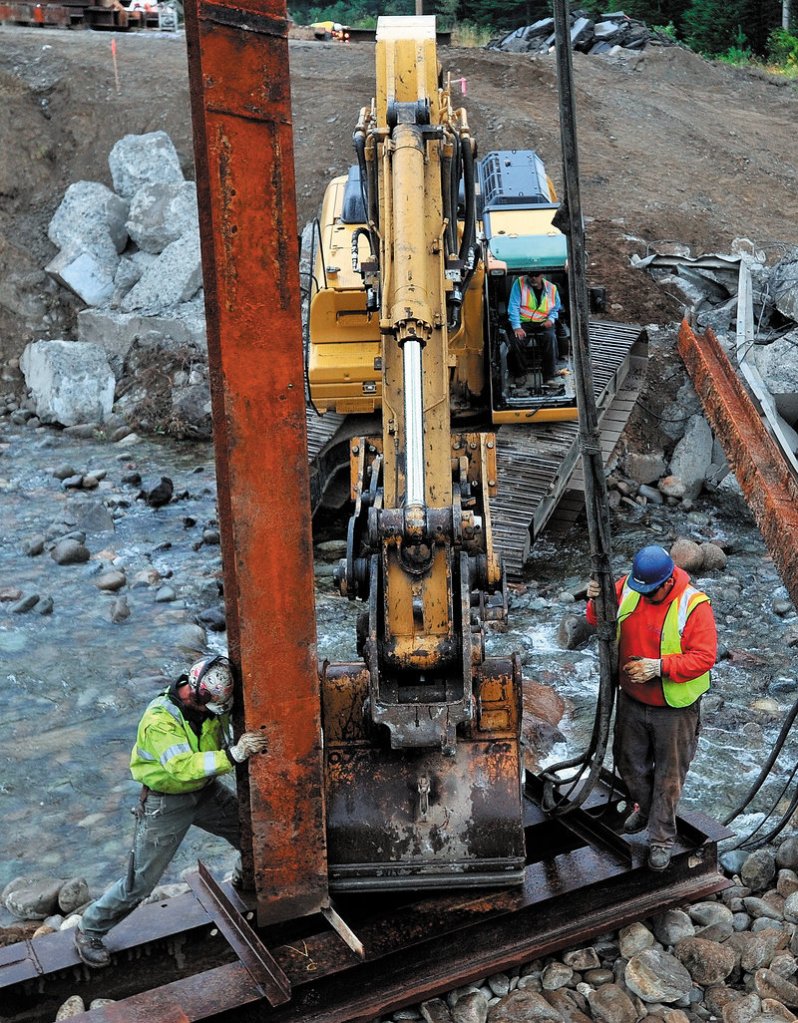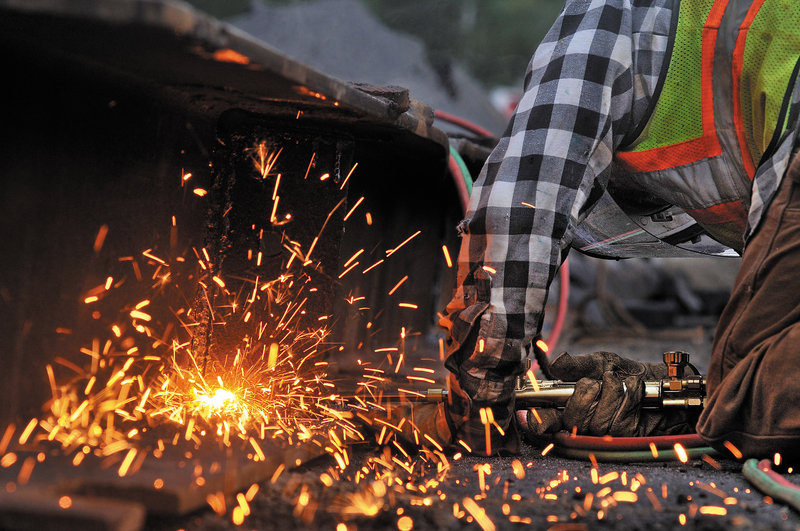The collapse of two bridges in Carrabassett Valley during Tropical Storm Irene raised a larger issue: that Maine is not spending enough money to maintain its aging bridges.
The two bridges, 300 yards apart on Route 27, collapsed within minutes of each other around 4:30 p.m. Aug. 28 as the storm dumped more than 8 inches of rain on the area.
“We have to treat it as a warning,” said state Sen. Bill Diamond, D-Windham, the lead Senate Democrat on the Legislature’s Transportation Committee.
But transportation officials say it’s difficult to draw broad conclusions from the failure of the bridges because the flood conditions were so extraordinary.
“This is an extreme, extreme event,” said John Buxton, bridge maintenance engineer for the Maine Department of Transportation.
Thirty-four percent of the bridges in Maine that are subject to federal inspection requirements are deficient, and Maine needs to spend $1.3 billion over the next 10 years to upgrade them, says a report by the American Society of Civil Engineers.
While Maine lacks funding like other states, its problem is exacerbated by its terrain and its small population, said Maria Fuentes, executive director of the Maine Better Transportation Association.
Maine is an unusually watery state, with 32,000 miles of rivers and streams, and the Department of Transportation is responsible for inspecting 2,758 bridges. Yet the formula for federal highway funding is based largely on population, and Maine ranks 41st.
“The blessings of God, expressed in our streams, lakes, rivers and mountains, have become a challenge now,” said Dana Connors, who was the state’s transportation commissioner for 11 years and is now president of the Maine State Chamber of Commerce.
Money from a $160 million bond that Maine voters approved in 2008 for bridge repairs and replacements will run out after next year, Fuentes said.
When it had Democratic majorities, the Legislature customarily put a transportation bond on the ballot in the first of its two regular sessions. This year, the GOP-controlled Legislature did not.
Many Republicans say the state can’t afford to borrow so much money and should spend more on transportation from its General Fund.
Rep. Richard Cebra, R-Naples, House chairman of the Transportation Committee, said he agrees that the state must spend more money repairing bridges but the incident in Carrabassett Valley isn’t a good case for a funding argument.
“It was a natural disaster,” he said. “It was a hurricane.”
Irene brought 8.5 inches of rain to the area in northern Franklin County, according to the National Weather Service. That topped the previous record by more than 3 inches, Buxton said.
Moreover, that stretch of Route 27 is in a narrow mountain valley that acts as a funnel during heavy rainstorms, he said.
Buxton said he believes that debris downstream from the Brackett Brook bridge created a dam that raised the water level by 2 feet in less than 15 minutes, causing the brook to spill over the bridge.
At that point, he said, the bridge was doomed because its structural support was undermined by the churning water.
The two bridges that collapsed were very different from each other — another indication that the conditions would have overwhelmed any bridge, Buxton said.
The bridge that crossed the Carrabassett River, built in 1958, was being monitored during the storm because it was on a list of 164 bridges that have been identified as being vulnerable to erosion during flooding. That bridge’s foundation, in the streambed, put the bridge at risk when the rising water caused the bed to shift, Buxton said.
The bridge was scheduled for an upgrade next year.
The Brackett Brook bridge was built in 1999 to modern standards, to replace a smaller bridge that was seen as vulnerable to flooding.
Buxton said the transportation department has about $3 million to address the bridges identified as having the most serious problems. It doesn’t have a good handle on how many bridges it can fix with $3 million — maybe as many as 25 or as few as five, he said.
Until the state upgrades all of the bridges that are vulnerable to erosion, it has a system to make sure they are safe, Buxton said.
During every storm, hundreds of transportation department workers fan out across the state to monitor the bridges. A yellow-and-red fluorescent gauge is attached to the foundation of each bridge, enabling a worker to measure a river’s depth at night with a flashlight.
Some bridges are monitored every two or three hours, Buxton said, while others, in some conditions, are monitored every 15 minutes.
Each bridge has its own plan that stipulates how often it is monitored, at what point the monitoring is increased, and when the bridge is closed to heavy vehicles or to all vehicles. The two bridges in Carrabassett Valley had never been closed or posted for weight limits.
Buxton said a transportation department employee checked the Carrabassett River bridge about an hour before it collapsed, then went north to Wyman Township to monitor more bridges.
When the monitor returned to Carrabassett Valley, he couldn’t reach the bridge because a sudden increase in water blocked his path.
MaineToday Media State House Writer Tom Bell can be contacted at 791-6369 or at:
tbell@mainetoday.com
Copy the Story Link
Send questions/comments to the editors.





Success. Please wait for the page to reload. If the page does not reload within 5 seconds, please refresh the page.
Enter your email and password to access comments.
Hi, to comment on stories you must . This profile is in addition to your subscription and website login.
Already have a commenting profile? .
Invalid username/password.
Please check your email to confirm and complete your registration.
Only subscribers are eligible to post comments. Please subscribe or login first for digital access. Here’s why.
Use the form below to reset your password. When you've submitted your account email, we will send an email with a reset code.